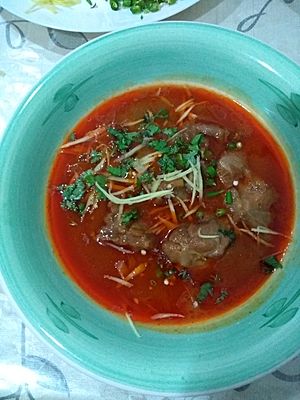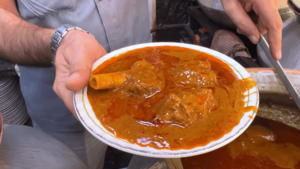Nihari facts for kids
|
Nihari serving in Old Delhi, India
|
|
| Course | Breakfast, lunch, dinner |
|---|---|
| Place of origin | Indian subcontinent |
| Region or state | Lucknow, Awadh |
| Associated national cuisine | Indian, Pakistani, Bangladeshi |
| Invented | 18th century |
| Serving temperature | Hot |
| Main ingredients | Shank cut of, beef, ,(mainly in Pakistan), lamb and mutton, goat meat, or camel meat, as well as chicken and bone marrow |
| Other information | Served with naan or rice |
Nihari (Hindi: निहारी; Bengali: নিহারী; Urdu: نہاری) is a stew originating in Lucknow, the capital of 18th-century Awadh under the Mughal Empire in the Indian subcontinent. It consists of slow-cooked meat, mainly a shank cut of beef, lamb and mutton, or goat meat, as well as chicken and bone marrow. It is flavoured with long pepper (pippali), a relative of black pepper.
Contents
Etymology
The name nihari originates from Arabic nahâr (نهار), meaning "morning"; it was originally eaten by nawabs in the Mughal Empire as a breakfast course following Fajr prayer.
History
According to many sources, nihari originated in the royal kitchens of Lucknow, Awadh (modern-day Uttar Pradesh, India), in the late 18th century, during the last throes of the Mughal Empire. It was originally meant to be consumed as a heavy, high-energy breakfast dish on an empty stomach by working-class citizens, particularly in colder climates and seasons. However, the dish later gained a significant amount of popularity and eventually became a staple of the royal cuisine of Mughal-era nawabs.
Nihari developed with the overall cuisine of the Muslims of the Indian subcontinent. It remains a popular delicacy, especially in parts of Old Delhi, Lucknow, Dhaka, and Chittagong. The dish is known for its spiciness, taste, texture, and gravy.
Popularity
Nihari is a traditional dish among the Indian Muslim communities of Lucknow, Delhi, and Bhopal. Following the partition of India in 1947, many Urdu-speaking Muslims from northern India migrated to Karachi in West Pakistan and Dhaka in East Pakistan, and established a number of restaurants serving the dish. In Karachi, nihari became a large-scale success and soon spread in prominence and availability across Pakistan.

In some restaurants, a few kilograms from each day's leftover nihari is added to the next day's pot; this reused portion of the dish is known as taar and is believed to provide a unique flavour. Some nihari outlets in Old Delhi claim to have kept an unbroken cycle of taar going for more than a century.
Medicinal remedies
Nihari is also used as a home remedy for fever, rhinorrhea, and the common cold.
See also
 In Spanish: Nihari para niños
In Spanish: Nihari para niños


